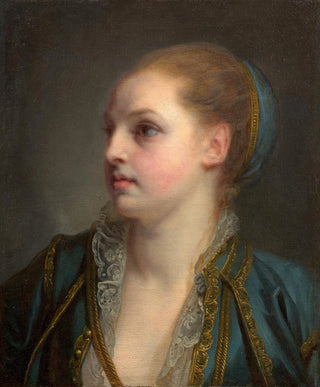Art print | Presumed portrait of Mademoiselle Clairon - Jean-Baptiste Greuze


View from behind

Frame (optional)
In the fascinating world of art, some works stand out for their ability to capture the essence of a bygone era and tell timeless stories. The art print Presumed portrait of Mademoiselle Clairon - Jean-Baptiste Greuze is a perfect example. This painting, which depicts the famous 18th-century French actress Mademoiselle Clairon, is much more than a simple portrait. It is an open window into a time when art and theater intertwined, revealing the nuances of social and cultural life in old France. Through this artwork, Greuze invites us to explore human emotions, beauty, and the complexity of interpersonal relationships, while paying tribute to an iconic figure of his time.
Style and uniqueness of the work
Jean-Baptiste Greuze's style is characterized by sensitivity and finesse that set him apart from his contemporaries. In the portrait of Mademoiselle Clairon, the artist uses a delicate color palette and subtle play of light to highlight the beauty and grace of his model. The meticulous details, such as reflections in the eyes and the texture of the clothing, demonstrate his technical skill and commitment to realism. What makes this art print particularly unique is the way Greuze manages to capture not only the physical appearance of Mademoiselle Clairon but also her character and charisma. The actress's penetrating gaze, combined with an expression that is both gentle and determined, creates an immediate connection with the viewer, immersing them in the emotional universe of the artwork.
The artist and his influence
Jean-Baptiste Greuze, born in 1725, is one of the most influential artists of the 18th century. Through his works, he revitalized the genre of portraiture by incorporating narrative and emotional elements, which had a significant impact on French art. Greuze was a pioneer of sentimentality in art, placing emotion at the heart of his creations. His ability to depict everyday life, family relationships, and human feelings inspired many artists after him, contributing

Matte finish

View from behind

Frame (optional)
In the fascinating world of art, some works stand out for their ability to capture the essence of a bygone era and tell timeless stories. The art print Presumed portrait of Mademoiselle Clairon - Jean-Baptiste Greuze is a perfect example. This painting, which depicts the famous 18th-century French actress Mademoiselle Clairon, is much more than a simple portrait. It is an open window into a time when art and theater intertwined, revealing the nuances of social and cultural life in old France. Through this artwork, Greuze invites us to explore human emotions, beauty, and the complexity of interpersonal relationships, while paying tribute to an iconic figure of his time.
Style and uniqueness of the work
Jean-Baptiste Greuze's style is characterized by sensitivity and finesse that set him apart from his contemporaries. In the portrait of Mademoiselle Clairon, the artist uses a delicate color palette and subtle play of light to highlight the beauty and grace of his model. The meticulous details, such as reflections in the eyes and the texture of the clothing, demonstrate his technical skill and commitment to realism. What makes this art print particularly unique is the way Greuze manages to capture not only the physical appearance of Mademoiselle Clairon but also her character and charisma. The actress's penetrating gaze, combined with an expression that is both gentle and determined, creates an immediate connection with the viewer, immersing them in the emotional universe of the artwork.
The artist and his influence
Jean-Baptiste Greuze, born in 1725, is one of the most influential artists of the 18th century. Through his works, he revitalized the genre of portraiture by incorporating narrative and emotional elements, which had a significant impact on French art. Greuze was a pioneer of sentimentality in art, placing emotion at the heart of his creations. His ability to depict everyday life, family relationships, and human feelings inspired many artists after him, contributing






